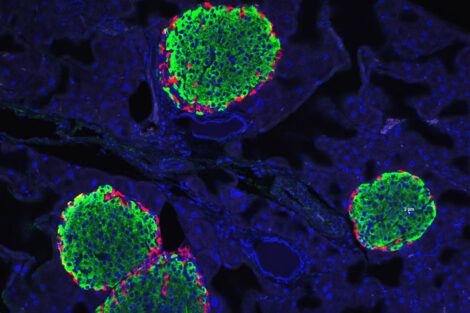For immediate release: Wednesday, December 8, 2021
Boston, MA – A newly discovered hormone named fabkin helps regulate metabolism and may play an important role in the development of both type 1 and type 2 diabetes, according to research led by the Sabri Ülker Center for Metabolic Research at Harvard T.H. Chan School of Public Health.
The study showed blood levels of fabkin were abnormally high in mice and human patients with either type 1 or type 2 diabetes. The researchers found that blocking the activity of fabkin prevented the development of both forms of diabetes in the animals. Fabkin likely plays a similar role in humans and the hormone complex could be a promising therapeutic target, according to the researchers.
“For many decades, we have been searching for the signal that communicates the status of energy reserves in adipocytes to generate appropriate endocrine responses, such as the insulin production from pancreatic beta cells,” said senior author Gökhan S. Hotamisligil, director of the Sabri Ülker Center. “We now have identified fabkin as a novel hormone that controls this critical function through a very unusual molecular mechanism.”
The findings were published online in Nature on December 8, 2021.
Many hormones are involved in the regulation of metabolism, such as insulin and leptin. Fabkin is different from traditional hormones in that it is not a single molecule with a single defined receptor. Instead, fabkin is composed of a functional protein complex consisting of multiple proteins, including fatty acid binding protein 4 (FABP4), adenosine kinase (ADK) and nucleoside diphosphate kinase (NDPK). Through a series of experiments, the researchers determined that fabkin regulates energy signals outside of cells. These signals then act through a family of receptors to control target cell function. In the case of diabetes, fabkin controls the function of beta cells in the pancreas that are responsible for insulin production.
More than a decade ago, Hotamisligil and colleagues discovered that a protein known as FABP4 is secreted from fat cells during lipolysis, the process in which lipids stored within fat cells are broken down, typically in response to starvation. Numerous studies have since shown correlations between circulating FABP4 and metabolic diseases including obesity, diabetes, cardiovascular disease, and cancer. However, the mechanism of action was unknown.
In the new study, the researchers showed that when FABP4 is secreted from fat cells and enters the blood stream, it binds with the enzymes NDPK and ADK to form the protein complex now identified as fabkin. In this protein complex, FABP4 modifies the activity of NDPK and ADK to regulate levels of molecules known as ATP and ADP, which are the essential units of energy in biology. The researchers discovered that surface receptors on nearby cells sense the changing ratio of ATP to ADP, triggering the cells to respond to the changing energy status. As such, fabkin is able to regulate the function of these target cells.
The authors showed that the insulin-producing beta cells of the pancreas are a target of fabkin and that the hormone is a driving force behind the development of diabetes. When the researchers used an antibody to neutralize fabkin in mice, the animals did not develop diabetes. When the antibody was given to obese, diabetic mice, they reverted to a healthy state.
“The discovery of fabkin required us to take a step back and reconsider our fundamental understanding of how hormones work,” said lead author Kacey Prentice, research associate in the Sabri Ülker Center and Department of Molecular Metabolism. “I am extremely excited to find a new hormone, but even more so about seeing the long-term implications of this discovery.”
Other Harvard Chan School researchers who contributed to this study include Jani Saksi, Lauren Robertson, Grace Lee, Karen Inouye, Kosei Eguchi, Alexandra Lee, Ozgur Cakici, Emily Otterbeck, Paulina Cedillo, Ediz Calay, and Feyza Engin.
Funding for this study came from National Institutes of Health grant DK123458 and Juvenile Diabetes Research Foundation grants 2-SRA-2019-660-S-B and 3-PDF-2017-400-A-N. Development of a therapeutic antibody to target fabkin in metabolic disease is also being supported by Lab1636, an affiliate of Deerfield Management.
“A hormone complex of FABP4 and nucleoside kinases regulates islet function,” Kacey J. Prentice, Jani Saksi, Lauren T. Robertson, Grace Y. Lee, Karen E. Inouye, Kosei Eguchi , Alexandra Lee, Ozgur Cakici, Emily Otterbeck, Paulina Cedillo, Peter Achenbach, Anette-Gabriele Ziegler, Ediz S. Calay, and Gökhan S. Hotamisligil, Nature, December 8, 2021, DOI: 10.1038/s41586-021-04137-3
image: Kacey Prentice
For more information:
Nicole Rura
nrura@hsph.harvard.edu
617.221.4241
Visit the Harvard Chan School website for the latest news, press releases, and multimedia offerings.
###
Harvard T.H. Chan School of Public Health brings together dedicated experts from many disciplines to educate new generations of global health leaders and produce powerful ideas that improve the lives and health of people everywhere. As a community of leading scientists, educators, and students, we work together to take innovative ideas from the laboratory to people’s lives—not only making scientific breakthroughs, but also working to change individual behaviors, public policies, and health care practices. Each year, more than 400 faculty members at Harvard Chan School teach 1,000-plus full-time students from around the world and train thousands more through online and executive education courses. Founded in 1913 as the Harvard-MIT School of Health Officers, the School is recognized as America’s oldest professional training program in public health.
